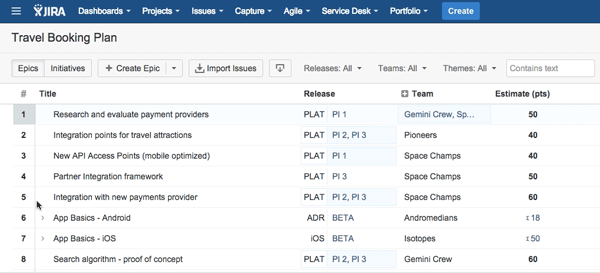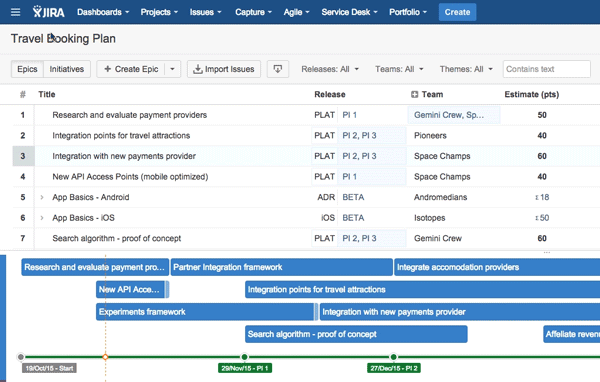There are a lot of stakeholders involved in the planning process, each with different needs, and as you’d expect, they all use Portfolio for Jira differently. So, we’re doing a series on Portfolio for Jira ‘across the team’ to show you how different team members can use it, starting with product managers.
Product managers need reliable roadmaps
 As a product manager, you are the voice of the customer in product planning, so you have tons of feature ideas and customer feedback. When planning, you need a way to quickly turn these ideas into a compelling product roadmap to keep stakeholders informed (and for your own guidance!). You also need visibility into the teams’ progress so you can keep your plan up-to-date as things change – by doing quick what-if scenarios, making trade-off decisions and prioritizing to get the right things done first. If this sounds like you, keep reading to learn about three ways Portfolio for Jira can help you plan better.
As a product manager, you are the voice of the customer in product planning, so you have tons of feature ideas and customer feedback. When planning, you need a way to quickly turn these ideas into a compelling product roadmap to keep stakeholders informed (and for your own guidance!). You also need visibility into the teams’ progress so you can keep your plan up-to-date as things change – by doing quick what-if scenarios, making trade-off decisions and prioritizing to get the right things done first. If this sounds like you, keep reading to learn about three ways Portfolio for Jira can help you plan better.
1. Organize ideas
First, getting all of those feature requests, new ideas, and customer feedback into one place is paramount because you need to lay everything on the table before you can even begin to think about prioritization. Start by defining initiatives in Portfolio for Jira – think of initiatives as ‘big chunks of work’ that span multiple epics and/or teams – so you can get a big picture view of all of the things that need to be done in the next planning cycle (we tend to plan quarterly).
Once you’ve defined initiatives, they need to be broken down into more consumable pieces to populate the backlog. This can be done as a combination of:
- Breaking down initiatives into new epics and stories: Slice out tangible and incrementally shippable pieces of work. This can be done inside Portfolio for Jira, and once the epics and stories are ready for implementation, they can be turned into actual Jira issues.
- Importing existing epics and stories: Import all of the relevant epics and stories that already exist in Jira (at Atlassian, this includes things like customer suggestions gathered on jira.atlassian.com) and assign them to the right initiatives.
Once the backlog is populated, it’s easy to reprioritize by dragging and dropping.

2. Build a roadmap
Once you have a backlog of ideas, the next step is getting everything on a roadmap to share with your stakeholders. The three things needed to build a roadmap are scope, time, and resources. In Portfolio for Jira, these equate to:
- Scope: Estimated backlog items in Jira Software (the backlog is already laid out above – the work just needs to be estimated).
- Time: Target release dates (they can be dynamic if you aren’t committed to dates).
- Resource: Teams and their velocity in hours or points (which can be linked directly to a board in Jira Software).

The ingredients of a roadmap are scope, time & people – and Portfolio for Jira does the baking.
Once Portfolio for Jira has these ingredients, it’ll mix them up and bake the cake for you. There’s no need for guesstimate roadmaps anymore!
3. Play with what-if scenarios
Now that there’s a data-driven roadmap in place, the real fun begins. Because all of the data in Portfolio for Jira is linked to Jira Software, it’s easy to play with what-if scenarios and instantly see the impact in the schedule.
As mentioned earlier, a roadmap is based on scope, time, and people, so these are the variables that you can play with in Portfolio for Jira to see different roadmap scenarios. What-if planning is also a great way to communicate openly with stakeholders and clearly point out the tradeoffs since the roadmap tells you what is realistically possible.

In the what-if scenario above, we moved an epic to an earlier release but the schedule went red. So we broke down the epic into an MVP version for release 1 and fully fledged version for release 2 to make the schedule go back to green.
Have another team member interested in how they can get value from Portfolio for Jira? Let us know in the comments so we can add it to the series. Then start creating realistic, data-driven roadmaps with your free trial of Portfolio for Jira.
Happy planning! 🙂
Get planning with Portfolio for Jira

